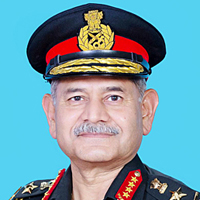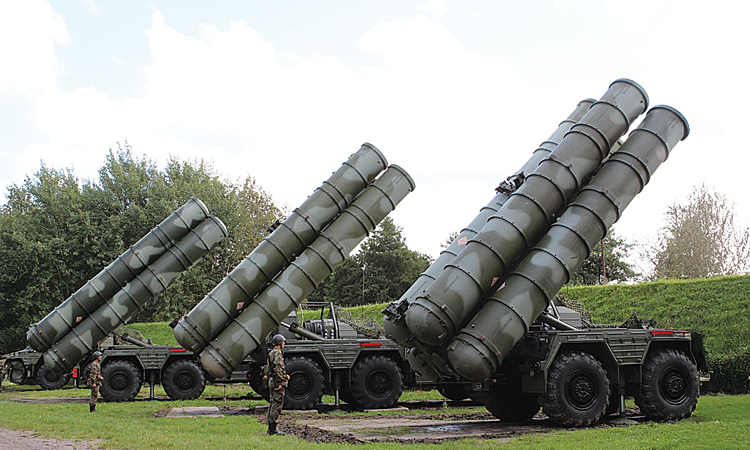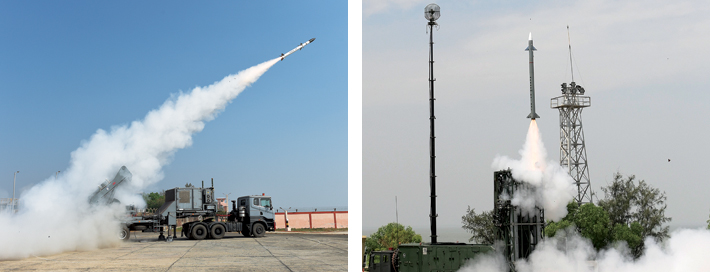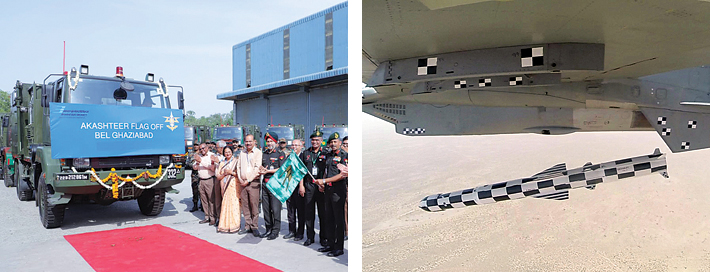INDIAN ARMED FORCES CHIEFS ON OUR RELENTLESS AND FOCUSED PUBLISHING EFFORTS

The insightful articles, inspiring narrations and analytical perspectives presented by the Editorial Team, establish an alluring connect with the reader. My compliments and best wishes to SP Guide Publications.

"Over the past 60 years, the growth of SP Guide Publications has mirrored the rising stature of Indian Navy. Its well-researched and informative magazines on Defence and Aerospace sector have served to shape an educated opinion of our military personnel, policy makers and the public alike. I wish SP's Publication team continued success, fair winds and following seas in all future endeavour!"

Since, its inception in 1964, SP Guide Publications has consistently demonstrated commitment to high-quality journalism in the aerospace and defence sectors, earning a well-deserved reputation as Asia's largest media house in this domain. I wish SP Guide Publications continued success in its pursuit of excellence.
Defending Indian Skies
During Operation Sindoor, Pakistan launched multiple attacks on India’s military installations and airfields, using missiles, rockets and drones. However, Pakistan’s every single projectile was intercepted by Indian Armed Forces and brought down before it could reach the intended target.
 | By AIR CHIEF MARSHAL V.R. CHAUDHARI (RETD), FORMER CHIEF OF THE AIR STAFF, INDIAN AIR FORCE |

There has been considerable discussion about the successful execution of Operation Sindoor. The Indian Air Force (IAF) not only conducted offensive operations efficiently, but also ensured that its robust Air Defence (AD) system prevented any Pakistani missiles, drones, or rockets from reaching their intended targets. What constitutes this integrated AD system? What are the technologies that support this capability? This article will provide the reader with a comprehensive historical perspective, enlightening them on how the IAF meticulously developed such a system.
EVOLUTION OF INDIA’S AIR DEFENCE CAPABILITIES
The Russia-Ukraine conflict has showcased some spectacular surface-to-air missile engagements, specifically those fired from the Man-Portable Air Defence Systems (MANPADS) used by both sides. Many of these MANPADS first appeared in Afghanistan in 1979 and have since been acquired by various terrorist organisations. Helicopters have become particularly vulnerable in areas heavily populated with shoulder-fired missiles of all hues. As a result, the Russian military has faced significant losses, including many helicopters and some fighter aircraft. In response to these losses, they began flying at higher altitudes to avoid the maximum effective ranges of these missiles. However, this tactic also made them susceptible to long-range radarguided missiles, which continued to impact their operational capabilities. In response, a focused, albeit limited, campaign was launched to suppress the Air Defence systems as a precursor to deep interdiction and strategic strikes.
The Middle East has witnessed a stark contrast between threats and actions. At times, short-range rockets launched by Hamas have been accompanied by long-range ballistic missiles from Iran, putting pressure on Israel’s air defences. The famed Iron Dome system, which integrates radar technology with surface-to-air missile systems (SAM), demonstrated its effectiveness by intercepting and destroying most of the incoming projectiles.

(LEFT) SUCCESSFUL FLIGHT-TEST OF NEW GENERATION AKASH MISSILE; (RIGHT) MEDIUM RANGE SURFACE TO AIR MISSILE.
Russia and China thoroughly analysed the conduct and outcomes of the first Gulf War, leading them to reorganise their forces and develop what is now known as Anti-Access Area Denial (A2AD) capabilities. In 2006, China issued a white paper on its national defence, with an emphasis on “information warfare”. This approach interlinked command and control systems with weaponry and also extended these networks to include space-based assets, cyber elements, and decisionmaking entities. Over the years, these capabilities have been strengthened through the induction and integration of newer ground-based and airborne weapons and sensors.
Our integrated Air Defence system, featuring shooters ranging from the S-400 to vintage L-70 guns, can counter almost all incoming projectiles, demonstrating the system’s robustness
In India, the first radar units were set up in the late 1950s, equipped with Marconi radars purchased from the United Kingdom (UK). After the 1962 debacle, India realised that deploying long-range radars would enhance air defence and air control. The United States of America (USA) agreed to sell six Star-Sapphire radars to us, and new units were raised across the northern and western borders. Unfortunately, while we did receive the equipment, the Americans did not fulfil the requirement of operationalising it due to their leanings after the 1965 war with Pakistan. The IAF had to rely on the technical prowess of its engineers to set up a new unit, the Electronic Engineering and Installation Unit, to not only get the radars operational but also to maintain them with minimal support. By the late 1960s, these radars were providing most of the air space surveillance along the western front. During the 1971 conflict, radar operators and fighter controllers carried out numerous successful interceptions of enemy fighters while also ensuring the safe recovery of their fighter aircraft. Just before the war, the IAF had also received the first lot of Soviet P-30 radars. This would have been the turning point in our AD capabilities, with two technologically diverse pieces of equipment performing the onerous role of defending Indian skies.
FROM PLAN-ADGES TO IACCS: BUILDING A CONNECTED SHIELD
However, communication between the radar units remained a weak area, aside from the significant gaps in radar coverage. In the true spirit of Atmanirbharta, the IAF conceived what was to be known as ‘Plan ADGES’ (Air Defence Ground Environment System), intending to interconnect all static and mobile radar stations with a reliable microwave communication system and to fill the gaps in radar coverage along the borders. This plan was to be based on indigenous capabilities and was steered by the Prime Minister’s Office through the Radar and Communications Project Organisation (RCPO). By the end of 1970, troposcatter communication units had formed a rudimentary network between the radar stations.

(LEFT) AKASHTEER SYSTEM; (RIGHT) AIR LAUNCHED BRAHOMS MISSILE.
With the induction of the French Thomson-CSF THD-1955 radar in the mid-1970s, radar coverage increased substantially, and Bharat Electronics Limited (BEL) had licensed-produced these along with the PSM-33 radars. The programme gained steam, and over the next three decades, ADGES served the IAF and the nation well. Based on the reliable communication system, the air defence operations underwent many systematic changes. The low-level radars provided Ground Control Intercept (GCI) capabilities, and GCI units were brought under the control of Air Defence Direction Centers. (ADDCs). The western and northern fronts were covered by numerous ADDCs, which featured a combination of high-power radars, low-level radars, and even Mobile Observation Posts (MOPs), providing surveillance, as well as intercept and recovery directions for fighter aircraft.
Another turning point in AD capabilities came after a Latvian-registered An-26 aircraft dropped a large cache of arms in the Purulia district of West Bengal in December 1995. It was later intercepted and forced to land in Mumbai. The lack of pan-India radar coverage was the primary reason the aircraft remained undetected in Indian airspace. The government formed a committee that determined that a large number of radars would be required to fill in the gaps, particularly in peninsular India. This resulted in the procurement of a large number of static and mobile radars, most of which were designed and developed by the Electronics & Radar Development Establishment (LRDE) and manufactured by BEL.
The Integrated Air Command and Control System (IACCS) was developed, which now interconnects all surveillance systems — both airborne and ground-based — with the shooters, specifically the fighter aircraft and SAMs
Integrating radars of multiple origins and varying technologies was a big challenge. The Automatic Data Handling System, developed by BEL, could overcome the problem to some extent. However, the growing civil air traffic, along with the introduction of new-generation fighter aircraft, necessitated the establishment of data sharing and secure communications between Radar units and ADDCs. In the early years of this century, the IAF conceived a terrestrial network, the AFNET (Air Force Network), that would link all units through a secure medium. The next step was to develop a fully automated data handling system that would provide a recognised air picture of the entire Indian airspace.
During peacetime and conflict situations, the IAF carries out 24/7 air defence duties, including surveillance, facilitating civilian air traffic through Air Defence Identification Zones (ADIZ), and maintaining air defence alerts with fighter aircraft and SAMs. To put it into perspective, over 10,000 flights originate from or transit over the country every day. Each one is to be assigned an Air Defence Clearance number and must be identified. Given the considerable responsibility of safeguarding the vast airspace, the IAF recognised the need for automation and networking aided by robust decisionsupport systems.
The Integrated Air Command and Control System (IACCS) was developed, which now interconnects all surveillance systems — both airborne and ground-based — with the shooters, specifically the fighter aircraft and SAMs. The surveillance elements provide a fused, common air picture that has allowed the IAF to retain centralised command over all elements. However, due to the vast geographical span of the country and regional commands having independent control over allotted resources, the system allows for distributed control over air defence activities. Finally, the shooters are granted full authority to execute the mission. This decentralised execution provides flexibility and a shorter decision-making chain. This feature of centralised command and decentralised execution sets the IAF apart from the other services, which need resources to be placed under command for effective utilisation.
OPERATION SINDOOR: A REAL-TIME TEST OF INTEGRATION AND PRECISION
During Operation Sindoor, Pakistan launched multiple attacks on India’s military installations and airfields, using the Fatah-2 rockets and an assortment of drones. Pakistan’s every single projectile was intercepted and brought down before it could reach the intended target. The IACCS proved its worth by rapidly detecting, identifying, and allocating targets to the appropriate weapon system for destruction.

The biggest challenge to any air defence system is the ability to engage targets with widely varying parameters. The terminal speed of a ballistic missile can be thousands of kilometres per hour, while small drones may fly at speeds as low as 25 kmph to 30 kmph. Our integrated Air Defence system, featuring shooters ranging from the S-400 to vintage L-70 guns, can counter almost all incoming projectiles, demonstrating the system’s robustness.
THE FUTURE OF AIR DEFENCE: NETWORK-CENTRIC WARFARE AND EMERGING TECHNOLOGIES
Keeping pace with technology, the IAF has periodically upgraded the hardware and software of the AFNET and IACCS. Weapon systems have been digitised, and the architecture of IACCS now permits newer equipment to plug and play. Counter-drone systems operated by multiple agencies can now be efficiently utilised, and with Artificial Intelligence (AI)-based decision support systems, the capabilities of our Air Defence system can ensure the sovereignty of Indian air space. The need of the hour is the rapid induction of VHF (Very High Frequency) radars to detect stealth and low-observable platforms, as well as passive radar systems and highly mobile, high-power radars. To maintain a decisive advantage over our adversaries, we will need 4.5 to 5th-generation aircraft equipped with beyond-visual-range weapons and long-range SAMs in sufficient quantities.
Aerospace domain awareness is another area that requires strengthening. This requires seamlessly linking airborne and ground-based sensors with space-based assets to provide information on all cooperative and non-cooperative targets, extending up to near space. Ballistic missile defences and the protection of high-value assets depend on a high level of aerospace domain awareness.
The personnel of the IAF deserve credit for recognising the necessity of integrating all ground-based radars through the Plan-ADGES over half a century ago. This initiative eventually evolved into the IACCS, which played a crucial role in the success of Operation Sindoor.
The concept of network centric operations was adequately proven and networking of sensors, commanders, and shooters resulted in showing how a flatter hierarchy can reduce operational pauses, enhance precision and increase speed of command. Tactical interoperability with the Army’s Akashteer system ensured that human soldiers manning AD gun systems along with their command & control systems, could be seamlessly connected in a single communication fabric, with a common battle management system. The future lies in ensuring that Network-centric warfare/operations remain the cornerstone of the ongoing transformation efforts.





